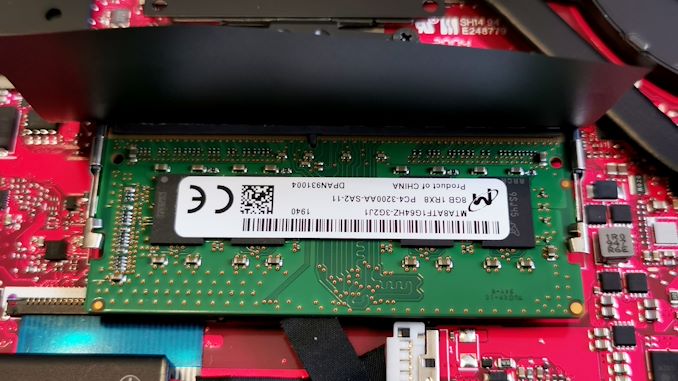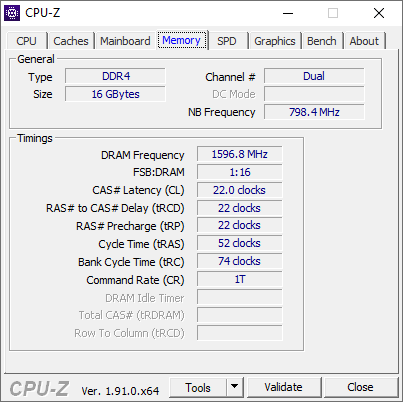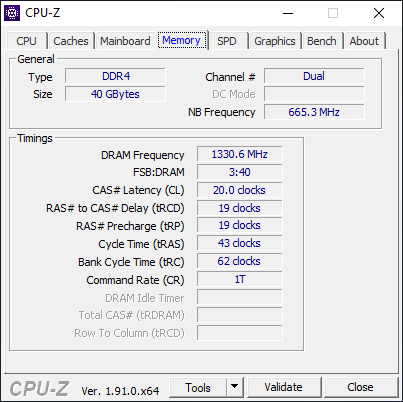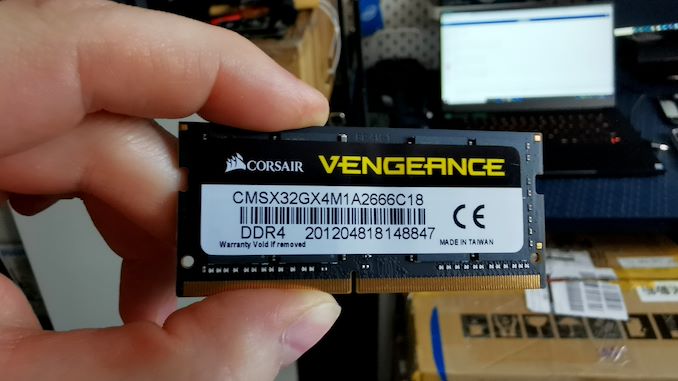AMD’s Mobile Revival: Redefining the Notebook Business with the Ryzen 9 4900HS (A Review)
by Dr. Ian Cutress on April 9, 2020 9:00 AM ESTRyzen 9 4900HS with DDR4-2666 and DDR4-3000
In our ASUS Zephyrus G14, we have a total of 16 GB of DDR4. This is split between a single SO-DIMM module of 8 GB, and a set of 8 GB memory soldered onto the board. AMD will offer a version with 16 / 16, however this might come at a later date.
This memory is running at the AMD recommended for these processors, DDR4-3200. Through our inspection tools, we can tell that this memory is running with subtimings of 22-22-22 with a command rate of 1T. The command rate is certainly good, however the 22-22-22 is a little slower than what we see on a desktop system running at this speed, because here we have a system that conforms to JEDEC’s subtiming requirements.
For our memory testing we wanted to see what speeds and capacities we could achieve. Corsair very kindly sent us some modules of 16 GB DDR4-3000 and a module of 32 GB DDR4-2666. This would give our system either 24 GB or 40 GB total respectively, which for a machine designed to do heavier duty workloads, having >16 GB is certainly welcome, as long as the performance hit isn’t too much.
I installed the 32 GB module, and the system booted first time with no fuss. A quick look to see if all the capacity was seen, and we had a total of 40 GB. The speed was also as expected, at DDR4-2666 but with subtimings of 20-19-19 1T.
However, when we put in the module of 16 GB DDR4-3000, to get a total of 24 GB, the detected speed inside the system was only DDR4-2666. Looking at the module settings, this was because the DDR4-3000 speed was actually an XMP profile, and ASUS has not enabled the ability to set XMP profiles here.
We were able to get DDR4-2666 on the 32 GB module because this is the base frequency and settings for the module. The same with the 8 GB module that came with the system – it was flashed so that the basic SPD setting was DDR4-3200. If users want to get high capacity modules with the faster DRAM speeds on this system, they will have to configure the primary SPD profile of their modules, which isn’t an easy thing to do.
As a result, our tests are going to come down to the 8 GB DDR4-3200 module that came with the system, and compare it to the 32 GB DDR4-2666 module. Note that the latter is an 8+32 configuration, which is expected to run in dual channel for the first 16 GB, and then single channel for the next 24 GB.



With our AI test, there’s a ~20% benefit from having the faster memory, which decreases slightly when moved to a limited power budget.

We didn’t see any difference in something like Cinebench.

There was more of a difference in PCMark 10, however PCM10 isn't that great in showing where the bottlenecks are.
Integrated Graphics Tests


For the Civ 6 graphics test, the difference in performance between the two memory settings is really significant. This sort of game cares less about FPS, however going down to 22 FPS for 1080p Max and No MSAA means that the user probably has to dial that back a bit to get something more reasonable.


Going from plugged in to not plugged in, we didn’t see much of a change with the slower memory, however the DDR4-3200 setting still gets a serious benefit over the DDR4-2666 arrangement.

For Final Fantasy, there a significant change - moving up from DDR4-2666 to DDR4-3200 affords a +30% improvement.
Discrete Graphics Tests




In each case, the faster DRAM actually improves discrete graphics performance.
Quick Thoughts
Overall, 16 GB of memory in a system like this isn't the best configuration - people who need the power are going to likely want 32 GB. However, users putting in their own fast module when buying the 16 GB version are going to have to be careful about the performance. Both the integrated graphics and the discrete graphics take a knock on performance going down from DDR4-3200 to DDR4-2666.















267 Comments
View All Comments
Gondalf - Friday, April 10, 2020 - link
I find crazy to compare an 8 core Laptop to a 6 core one.Intel is plenty of 45W 8 cores SKUs for laptops with turbos at over 5Ghz, and we are here to show nothing.
So basically AMD can only compete with a 6 core Coffee lake???
Irata - Friday, April 10, 2020 - link
There are reviews that show the eight core can‘t keep up either or just barely and that is in a huge and heavy chassis (i.e. the portable desktop type). And their battery life is even worse, as is their power consumption.Oh, and looking at this review, the six core is coupled with a faster RTX 2060 GPU...
Idontknowhatosay - Friday, April 10, 2020 - link
Der8auer did a comparison against the 9980HK and the 4900HS still came on top in performance. It even manages to keep up with the 5 GHz, 90 watt core i9 inside the Helios 700, which is a beast of a laptop in terms of size and weight.Omega215D - Friday, April 10, 2020 - link
goddamn intel fanboys truly want to distort shit so there is no real competition left in this space.Namisecond - Monday, April 13, 2020 - link
There is no real consumer "competition" in this space. Intel's 10nm production is fubar'd for the time being, To the point where expected products are just now trickling into the market place. AMD could capitalize on this, but their production is constrained because they don't have full control of their own production. This is the mobile market, not the desktop CPU market where you can have retail sales. OEMs are key here.2020 will be a bad year for laptop options.
vozmem - Friday, April 10, 2020 - link
Yes, you are right.It is crazy because the 6-core Razer laptop is also slightly more expensive than 8-core Asus laptop.
s.yu - Saturday, April 11, 2020 - link
In all fairness, Razer is usually more expensive than Asus.alufan - Friday, April 10, 2020 - link
hmm ok so the Intel CPU was supposed to be at 45w but could not maintain that probably du e to thermals, its supposed to clock higher but ditto and the 2060 is a higher performance version, however other tests still show the Ryzen ahead on 8 core Intels as well, it also seems to be a common result that the AMD is a long long way ahead on its battery life, not sure about other countries but this week in the UK we have had every online seller doing ads on TV pushing Intel laptops to the max, no doubt paid for by Intels rebate scheme dirty tricks me thinks but the truth will out gen 10 indeed lolDeicidium369 - Sunday, April 12, 2020 - link
95% of the market vs 5% of the market - that's called playing to the largest potential audience. Sorry but Intel outsells AMD at every single price point - regardless of what the AMD fanboys say - Revenues do not lie.Qasar - Sunday, April 12, 2020 - link
well other sites say different about who out sells who, others here have even posted links that show this."Revenues do not lie. " of course they dont, specially when you overcharge for your products